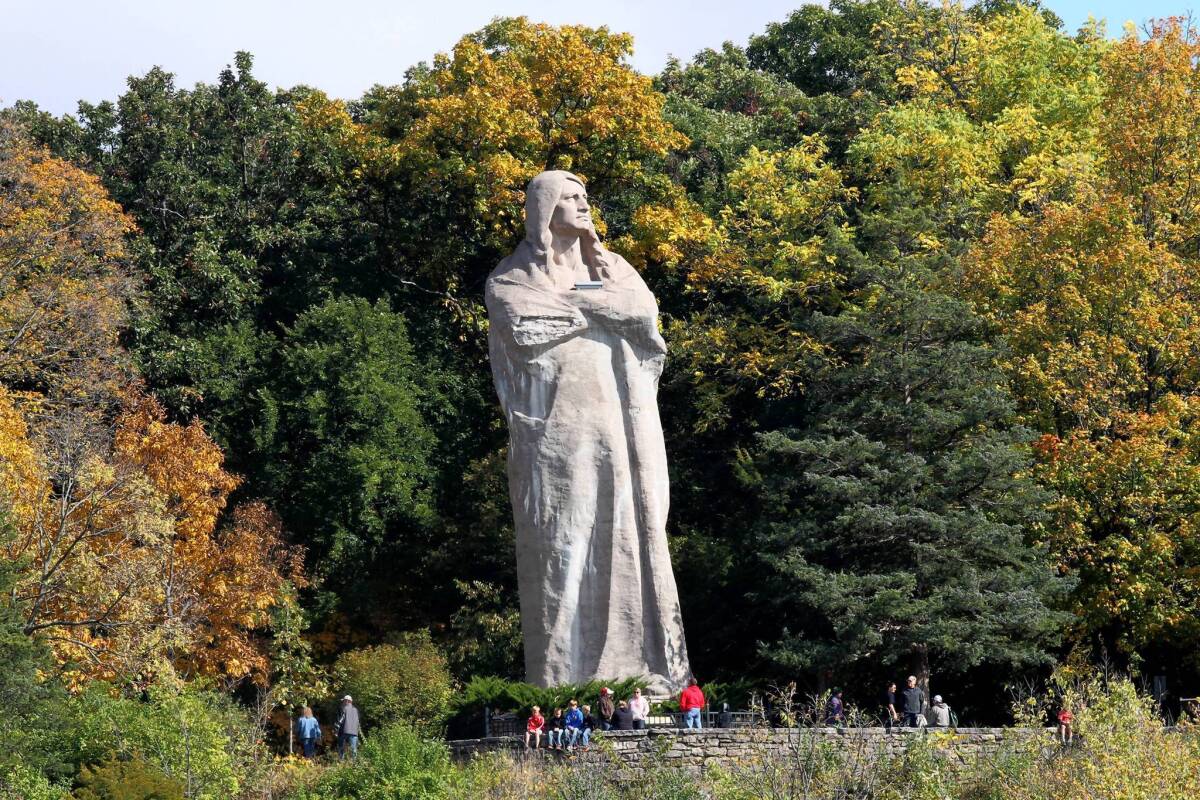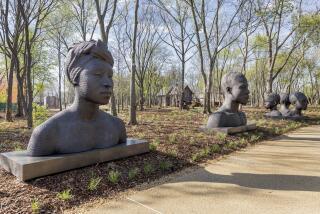Illinois town hopes its ‘Eternal Indian’ just lasts until spring

The slightly mournful face of what some might consider Illinois’ Statue of Liberty has weathered its 102 years remarkably well. It’s a focal point of the Eternal Indian, a 50-foot statue that towers over the Rock River about 100 miles west of Chicago.
But the body is so deteriorated that a flip of the finger can loosen chunks of its concrete surface. Deep cracks and gaping pock marks are spread throughout the statue.
Now, as winter looms, Frank and Charron Rausa have less concern about whether the beloved figure is eternal. They simply want it to last until spring. Then they will launch a crucial $700,000 restoration of the statue, which is widely known by the name of the Native American leader Black Hawk and has drawn the support of a certain National Hockey League organization.
“When we were there the other day, I just said, ‘Hold on, chief. Help’s on its way,’” said Charron Rausa, 77, of Sterling, Ill. “We’re praying that we don’t have a really bad winter, because he’s in bad shape.”
Its prospects would be much bleaker if it weren’t for the Rausas, both retirees who in 2008 read a newspaper story about the loss of state funding to restore the statue. The couple had grown deeply fond of the statue as a contemplative local landmark that preserves an important history of the region. It draws about 400,000 visitors a year to the area around Oregon, a town of 3,800.
“I sat there at the kitchen table and said, ‘Frank, the American people fixed the Statue of Liberty. Now, doggone it, we need to fix the Black Hawk statue.’”
Her husband, Frank, 71, who had worked as a grant writer, wrote one to acquire funding for the restoration, but it failed. The couple persisted, establishing a nonprofit, Friends of the Black Hawk Statue Committee, and getting the statue on the National Register of Historic Places.
They also embarked on a speaking tour, hitting Rotary and Kiwanis clubs, alumni associations and historical societies. The Rausas created “Pennies for Black Hawk,” which encouraged schoolchildren to contribute coins and connect with saving a statue that has been the focus of field trips for decades.
Time passed and their effort gained serious financial support from the Dillon Foundation in Sterling and the Illinois Department of Natural Resources. The Jeffris Family Foundation, based in Janesville, Wis., contributed a $150,000 matching grant, Frank Rausa said.
And in 2011 Chicago Blackhawks executives Jay Blunk and Pete Hassen visited the statue at the request of Scott Sypolt, chief legal counsel of the American Indian Center of Chicago. That visit led the hockey team, named for founder Frederic McLaughlin’s battalion in World War I — which in turn took its name from the Native American leader — to contribute to the restoration.
Rausa said the amount was significant, but he and team officials declined to specify.
Preliminary work started this month when engineers completed an ultrasound examination of the 100-ton structure, said to be the second-tallest monolithic concrete statue in the world. That work will be followed by core sampling to produce a thorough understanding of the original materials used and the extent of damage, Frank Rausa said.
A head-to-toe restoration of the statue will begin in spring. The figure’s head is solid concrete, which perhaps explains why it has fared better than the hollow body. One of the more intriguing aspects of the work will be the effort to restore the statue’s pinkish hue — an effect created by mixing granite chips from New England into the surface. During an earlier restoration, crews covered it with a concrete slurry.
Erected in 1911, the Eternal Indian was designed by renowned Chicago sculptor Lorado Taft and drew international press coverage at its opening. Taft designed it as a composite of several Native American men; it looks nothing like Black Hawk, a respected leader of Sac and Fox Indians, who were nearly wiped out after bloody battles in the area in 1832.
The restoration will run four to six months. The Rausas said an ideal conclusion would be to finish in time for Oregon Trail Days in July.
“But we don’t know,” Frank Rausa said. “We’ll try.”
More to Read
Start your day right
Sign up for Essential California for news, features and recommendations from the L.A. Times and beyond in your inbox six days a week.
You may occasionally receive promotional content from the Los Angeles Times.






